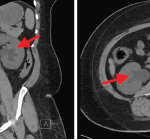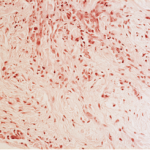In scleromyxedema, a patient’s hands may be hard to distinguish from those of someone with diffuse systemic sclerosis, but skin may have a papular quality that when touched feels like cobblestones, said Dr. Hummers. Scleromyxedema is systemic, rare, almost always found in adults, associated with monoclonal gammopathy of undetermined significance (MGUS), and its skin/neurological form is life threatening. Patients frequently have papules on the mid-back, and/or around the glabella, forehead and ears. Papules may coalesce, and skin texture is thickened.
“One of the clinical pearls in differentiating scleromyxedema from scleroderma is this very characteristic, distinct involvement of the ear, where you can see papules behind the ear.7 Even if you can’t see them, you will feel these papules,” said Dr. Hummers. Patients may also have distinct papules on their hands, sclerodactyly, and indentation of the skin on the knuckles called the “donut sign.” Patients may have elephantine thickening of the skin around their knees called pachydermia. Scleromyxedema can rarely progress to multiple myeloma or even smoldering myeloma, said Dr. Hummers.
Scleromyxedema may have scleroderma-like features, such as dysphagia and, less often, Raynaud’s phenomenon. Patients should have normal nailfold capillaroscopy and may have inflammatory polyarthritis in small hand joints. Patients with the life-threatening dermato-neuro syndrome present with encephalopathic symptoms that are non-specific, and may begin as confusion. They may rapidly progress to seizures and coma. Patients whose skin disease is well controlled very rarely have this manifestation, she said.
Diagnosis is made with physical exam, MGUS protein on blood screening panels and a skin biopsy. Look for mucin deposition that is apparent only with special staining, and separation between collagen bundles and increased spindled fibroblasts, she said. Scleromyxedema patients nearly all respond well to intravenous immunoglobulin, but maintenance therapy is required every six to 12 weeks for life, she said. Lenalidomide or thalidomide may be used to treat the underlying MGUS, but can have side effects that affect quality of life.
Scleredema is another very rare scleroderma mimic that is either post-infectious, associated with MGUS, or associated with poorly controlled type 2 diabetes, said Dr. Hummers.8 Skin tightening may become painful or restrictive. Patients present with a slowly progressive, doughy, non-pitting edema that typically begins around the upper back and neck, and then progresses to the upper arms, lower arms, chest, face and legs. Unlike scleroderma, it spares the fingers and feet.
Skin biopsy with special staining shows separation between collagen bundles and mucin deposition. Treat the underlying infection, MGUS or diabetes associated with scleredema. UVA-1 phototherapy may be effective for treating severe skin disease.


